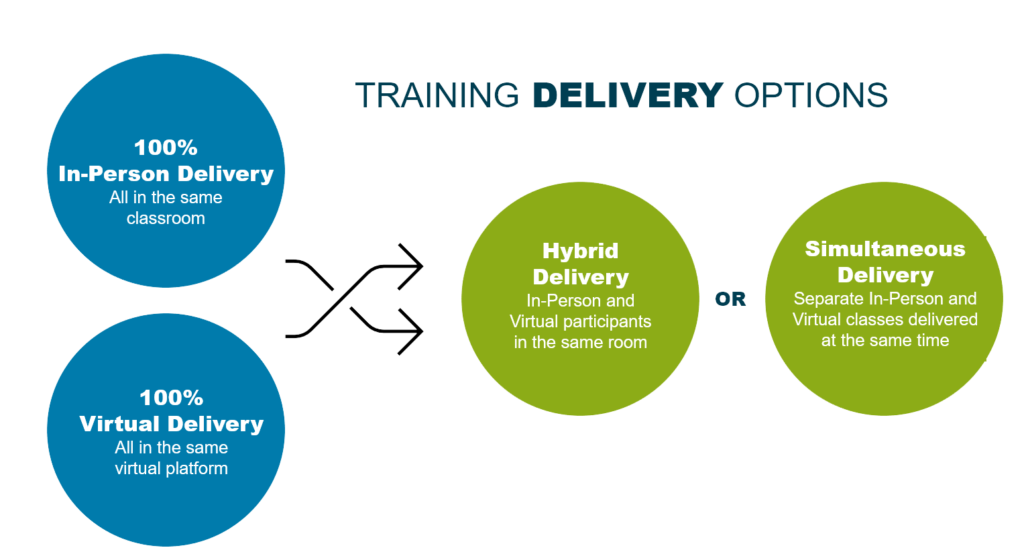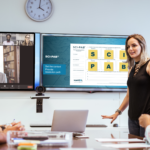With many of us returning to the office and others remaining remote, hybrid meetings have become commonplace in the workplace. We’ve seen a number of our clients installing sophisticated equipment upgrades to ensure their hybrid meetings are as efficient, productive, and collaborative as possible.
Clearly, when organizations need to conduct meetings – the hybrid environment is an obvious choice.
Training in the hybrid environment requires more
careful consideration.
The game changes when individuals are learning. In the training environment, it is important to immerse the participants in the content with as few distractions as possible – so they can easily learn, collaborate, and apply the content to speed their retention and adoption.
When we say, “hybrid training,” we mean delivering the same program to people learning together at the same time – with some joining in-person and some virtually.

Training in a hybrid environment may seem like an obvious choice, but it’s not always the best option. Unless carefully designed for, the hybrid environment could introduce complexity that can actually distract the learners and trainer.
Though we have great success training in the hybrid environment at Mandel, we don’t automatically jump to that delivery mode. Instead, we step back and evaluate each specific learning situation before deciding on the delivery approach to use.
Here are the questions that help us make the call.
To Hybrid or Not to Hybrid: 25 Helpful Questions
If your answers to the following questions are often yes, then delivering the training in a hybrid setting may be the best approach to take. If most of your answers are no, then you might want to consider using a single mode of delivery, redesigning the training for hybrid, or delivering the training simultaneously in deliberate groups who will best benefit from training virtually or in-person.
STRATEGY
Step back and consider the goals and outcomes you hope to achieve.
- Is creating a single shared experience essential to your overall objective?
- Do you need everyone to have the same experience simultaneously?
- Is the content of the training time sensitive?
DESIGN
Consider how well the training design and materials are optimized for a hybrid environment.
- Is the material for the training designed for a hybrid learning environment? If it was designed for in-person or virtual specifically, it most likely will require a design update for the hybrid environment.
- Does the design allow both the in-person and remote participants to practice, discuss, and engage each other and the materials in the same way? If not, you take the risk that either set of participants may feel excluded at any point in the design.
- Are the materials available for both in-person and electronic use? To be sure the remote participants feel included, is everything used in the class available electronically?
AUDIENCE
Think about who will participate and their learning styles and access to technology.
- Are you training a group of fewer than 25 people? Keep in mind, the larger the group, the more challenging it gets to include the virtual participants and make them feel they are getting the same experience as in-person participants. Additional resources may be needed.
- Are the participants an intact team? If not, think about whether breaking the group up into virtual and in-person groups may make better sense.
- Are most of the participants based in the same location?
- Are the participants familiar with the technology used in a hybrid training environment?
- Will participants speak up and raise issues? Equal engagement in a hybrid environment can be challenging – if your group is a quiet one, you may want to rethink your approach.
DELIVERY
Evaluate your facilitators’ environment and capability to access and engage using the available technology.
- Are your facilitators/SME’s skilled at engaging multiple audiences in a hybrid training environment? Engaging dual audiences can be challenging, and it is important that your facilitators are up to the challenge.
- Do you have enough staff to facilitate and monitor both the in-person and virtual participants?
- Are your facilitators/trainers comfortable using/leveraging different technology when delivering the training? Delivering in a hybrid environment may involve more complex technology – being sure your trainer/SME is comfortable manipulating and testing that technology is essential i.e., auto-framing video, monitors, tablets, mics, etc.
- Are you okay with your facilitator getting distracted by the technology and/or virtual audience and not pay as much attention to the people in the room? This dynamic happens time and again – it’s important to be okay with that if it does.
- Do you have a qualified producer to help facilitate the session and manage technical difficulties that may arise in the room and with the virtual audience?
TECHNOLOGY
Assess the technology you have available for a specific event to be sure it is optimal for the hybrid learning environment.
- Have you optimized the equipment in the room so all participants can have a similar experience i.e., auto-framing video, multi-location audio, screen set-up, etc.
- Have you tested the technology to be sure the instructor and/or participants in the room won’t have their backs to the remote participants – and that they can hear one another clearly?
- Do they have strong connectivity and high-powered computers?
- Will your equipment allow remote participants to have a presence in the room?
- Do you have fast enough wifi to support the technology for all those in the room and those joining virtually?
UNCERTAINTY
Assess whether the desire to hold the training in a hybrid environment outweighs the inherent complexity and uncertainty it introduces.
- Are you sure your class won’t get bumped out of the room that has the hybrid technology needed to conduct the training?
- Do you have a back-up plan if the in-person or virtual participants can’t join for some reason?
- Do you have a back-up plan if there are technical difficulties i.e., the camera, monitor, or audio don’t work?
- Are you prepared to have participants change back and forth from in-person to virtual attendance?
These questions are not designed to deter anyone from delivering training in a hybrid environment. Done with careful consideration and preparation, the results of hybrid training can be outstanding.
You just want to be sure to choose the BEST learning environment for your participants.
Our core piece of advice – don’t assume hybrid training is just like virtual or in-person – it is truly its own unique training approach that takes intentional design, technology, and content to really be successful.
Whatever you decide, the core principles that are the foundation of great learning experiences still hold – building relationships, encouraging communication, and learning with impact.
Want to learn more about our hybrid training solutions? Contact Mandel.







